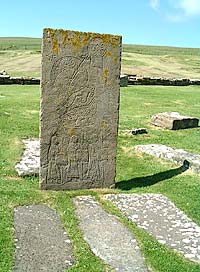Pict Clanns of Albann

Clann GUNN

The far north of Scotland is extremely
rich in prehistoric remains. There stands the mysterious brochs of the
proto-Picts and the superb stone sculpture of the Picts themselves. Their
intricately carved monuments survive along both shores of the Moray Firth.
When the Picts were overrun by the Gaelic Scots of Dalriada in the south, and by Vikings in the north, the survivors would naturally have taken refuge in inaccessible hinterlands behind the areas in which substantial evidence of their presence remained. It is precisely here, in the heights of the Caithness-Sutherland border, that Clann Gunn was to be found.
Some historians, have described Clann Gunn as Norwegian, others as Gaelic, but the fact remains, this was an ancient Clan of Picts who had occupied their land unbroken for over 8,000 years. Clan Gunn is of the Royal House of the Pictish province of Cath. (Note: Cat in P-Celtic [Welsh] is Cath. Cat in Irish and Scottish Gaelic is Cat; Cat in Breton is Kazh.)
The late Lord Lyon King of Arms, Sir Thomas Innes of Learney, stated the name was derived from the Norse Gunnr, meaning war. In the same way, Norse and Gaelic derivations are found for many local place-names that have survived from a lost prehistoric language. It is well known that the Picts borrowed extensively from other languages, both in place names and in personal names. First Greek, then Latin, and in turn, P-Celtic, Gaelic, Germanic Saxon, French, and finally English.
When Kenneth MacAlpine reigned as King of the southern Picts and the Dalriadic Scots, the northern Picts were beyond his reach. They held out in their splendid isolation from foreign control until Girig brought them into his enlarged Kingdom about 880 AD. Trustworthy Pict aristocrats were appointed as Mormaers in seven Pict provinces, and their families became hereditary overlords throughout the Picto-Scot Dynasty. Then as their power grew, Norman Kings started executing them into oblivion.
As the spreading Gaels and Normans fought each other for territories, the Gunns became more indented by their neighbours to the west, north and south. Their very survival became tenuous, particularly during the great conflict between the Norman Sinclair Earls of Caithness and the Norman Gordon Earls of Sutherland.
In the mid-15th century, the Clan Gunn Chief became the hereditary Crowner of Caithness. His insignia of office gave him the Gaelic title of Am Braisdeach Mór, (Wearer of the Big Brooch). It was as if the interlopers sought legitimacy by arranging for the approval of those who came before.
Despite their hardship, one of the greatest Scottish authors arose from their midst. Neil Gunn (1891 - 1973) of Dunbeath, wrote 20 novels about the people of his clan. They have been described as the finest work yet produced by a Scottish novelist. The Gunns suffered severely in the Clearances of the early 19th century. Today, they are scattered along the many small fishing communities of northern Scotland, indistinguishable from their neighbours.